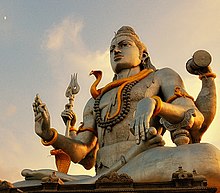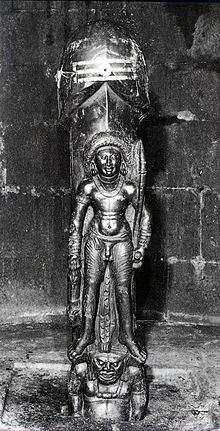Shiva

Shiva is the "destroyer of evil and the transformer" within the Trimurti, the Hindu trinity that includes Brahma and Vishnu.[1][12] In Shaivism tradition, Shiva is the Supreme being who creates, protects and transforms the universe.[13][14][15] In the goddess tradition of Hinduism called Shaktism, the goddess is described as supreme, yet Shiva is revered along with Vishnu and Brahma. A goddess is stated to be the energy and creative power (Shakti) of each, with Parvati the equal complementary partner of Shiva.[9][16] He is one of the five equivalent deities in Panchayatana puja of the Smarta tradition of Hinduism.[10]
According to the Shaivism sect, the highest form of Shiva is formless, limitless, transcendent and unchanging absolute Brahman,[17] and the primal Atman (soul, self) of the universe.[18][19][13] Shiva has many benevolent and fearsome depictions. In benevolent aspects, he is depicted as an omniscient Yogi who lives an ascetic life on Mount Kailash[1] as well as a householder with wife Parvati and his two children, Ganesha and Kartikeya. In his fierce aspects, he is often depicted slaying demons. Shiva is also known as Adiyogi Shiva, regarded as the patron god of yoga, meditation and arts.
The iconographical attributes of Shiva are the serpent around his neck, the adorning crescent moon, the holy river Ganga flowing from his matted hair, the third eye on his forehead, the trishula as his weapon and the damaru. He is usually worshipped in the aniconic form of Lingam.[2] Shiva is a pan-Hindu deity, revered widely by Hindus, in India, Nepal and Sri Lanka.

Rudra
Three-headed Shiva, Gandhara, 2nd century AD
Shiva shares many features with the Vedic god Rudra,[87] and both Shiva and Rudra are viewed as the same personality in Hindu scriptures. The two names are used synonymously. Rudra, the god of the roaring storm, is usually portrayed in accordance with the element he represents as a fierce, destructive deity.[88]
The oldest surviving text of Hinduism is the Rig Veda, which is dated to between 1700 and 1100 BC based on linguistic and philological evidence.[89] A god named Rudra is mentioned in the Rig Veda and the name Rudra is still used as a name for Shiva. In RV 2.33, he is described as the "Father of the Rudras", a group of storm gods.[90]
The hymn 10.92 of the Rigveda states that deity Rudra has two natures, one wild and cruel (rudra), another that is kind and tranquil (shiva).[91] The Vedic texts do not mention the bull or any other animal as the mount (vahana) of Rudra or other deities. However, post-Vedic texts such as the Mahabharata and the Puranas specifically state the Nandi bull, the Indian zebu as the vehicle of Rudra and of Shiva,
Thanks,
Please Upvote
Congratulations @mahadev11! You have completed some achievement on Steemit and have been rewarded with new badge(s) :
Click on any badge to view your own Board of Honor on SteemitBoard.
For more information about SteemitBoard, click here
If you no longer want to receive notifications, reply to this comment with the word
STOPDo not miss the last announcement from @steemitboard!